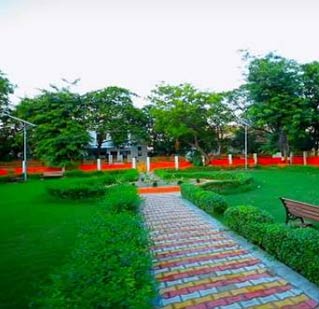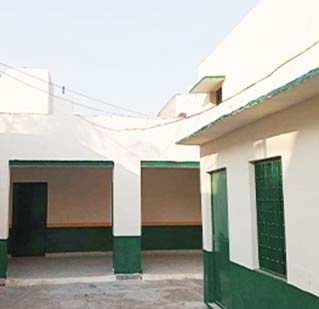Urban Development Department, Uttar Pradesh. In the year 2017, the government started ""Kanha Gaushala and Destitute Animal Shelter Scheme to stop cruelty towards cows and to rehabilitate destitute cows, under which Kanha Gaushala is constructed in the municipal bodies of the state. Arrangements for the maintenance of the cows preserved in cow sheds are made by the body from its own resources. As per the requirement, based on the demand of the body, the state government gives a grant of ₹ 50.00 per cow per day to the bodies. To make the Gaushala self-reliant, the urban body is continuously making efforts to develop the Gaushala as a tourist/pilgrimage destination and the Gaushala as an industry (based on cow products).
Purposes
The purpose of Kanha Cowshed is to establish an institution that is established for the welfare, maintenance, or nurturing of the bovine species, and for the welfare, shelter, security, and rehabilitation of abandoned, neglected, disabled, and weak bovine species.
Abandoned / Helpless Bovine
The term abandoned / helpless bovine refers to those bovine species that do not have an owner/caretaker and are found wandering in fields and on roads.
The condition of the bovine species due to which farmers/animal keepers abandon them (this is an illustrative example, not exhaustive)
- Male bovine species that are not being used by farmers/animal keepers.
-
Such female bovine species that
- Are not capable of conceiving.
- Are weak.
- Are affected by accidents.
- Are affected by infertility.
- Have permanent sterility.
- Are abandoned/helpless due to insignificant milk production capacity.
- Are dry.
Objectives
The purpose of establishing Kanha Cowshed is to provide shelter, provide security to bovine species, provide feed, medical treatment, and rehabilitate weak, diseased, injured, disabled, and abandoned bovine species."
- Average one cow attendant is required for the supervision of all regular activities of 50 cattle.
- The care of calves and newborn cattle require experienced and skilled workers.
- Two or three workers should be trained for artificial insemination (AI), primary healthcare, cattle identification, deworming, etc
-
Technically qualified individuals should be employed in large cowsheds, such as farm managers, cattle medical officers, stockmen, and office staff.
-
Cowshed construction
In order to bring uniformity in the Kanha Gaushala/Animal Shelter Homes being constructed in the municipal bodies, a model format of an action plan worth a maximum of Rs 165.89 lakh has been determined for keeping a minimum of 500 animals in the municipal bodies. According to the above format, cow sheds are required to have the following basic facilities: - fodder godown, shed for 500 cows, veterinary clinic with cattle crush, chaff cuttle shed, servant quarter, small size gate, main gate, charhi, drain construction work, submersible. Pump, bio gas plant, boundary wall. -
Shelter and Sustenance
By running a special campaign in the urban bodies, destitute cows are caught and given shelter in the Kanha Gaushala/Shelter Homes run by the body where they are given a balanced diet i.e. chaff and green fodder along with rock salt, jaggery and clean drinking water etc. -
Medical and Health
In urban areas, destitute cows injured in accidents are treated in the cow shelters run by the civic body with the help of competent officers/veterinary officers of the Animal Husbandry Department. In coordination with the competent officials of the Animal Husbandry Department, regular health check-up, treatment, deworming, vaccination etc. are done for the cows preserved in the cow shelters.
Cow Destitute
Destitute cattle means such cows which do not have any owner and are found roaming in the fields and on the roads. The condition of cattle due to which farmers/herders leave them destitute/destitute (this is an example, not complete)
a) Male cows which are not being used by farmers/animal herders. (E.g. bull, bull, calf etc.)
b) Such female cows which:-
- Inability to conceive.
- Be disabled.
- Get into an accident.
- Suffer from infertility!
- There should be permanent sterility.
- Destitute due to negligible milk production capacity.
-
Be dry.
Injured Cow
If any person sees any injured, injured or accident prone cow, then first of all inform the Municipal Corporation or Animal Husbandry Department. If possible, bring the said cow to the side of the main road and provide clean water for drinking. Do not drive injured/injured/sick cattle here and there and do not do any movement that may excite the animal like do not blow a loud horn, do not shine bright light directly on the face. When the vehicle of Municipal Body or Animal Husbandry Department arrives, help in transferring the animal to the vehicle.
Adopt Cow
The urban bodies provide protection to destitute cattle roaming in the city in Kanha Gaushala/animal shelters and provide them safe environment as well as balanced diet, clean drinking water and medical facilities. By contributing to the maintenance of the cows in the cow sheds run by the civic bodies, service to the cows can be done through the following means:-
- Donation for the welfare of cows.
- By adopting the cow progeny of Gaushala on monthly, yearly or lifetime basis.
- Keeping in mind the expenditure on fodder for the maintenance of each cow in the cow shed, by becoming a member on monthly, annual or lifetime basis for cow grass.
- By purchasing biogas, composted manure, cow ash, cow urine, gonail, cow lamp-murti etc. made in the cowshed.
- By providing free green fodder/chaff/jaggery etc. to the cow shed for the feeding of the cows.
- By donating the necessary equipment/materials for the operation of the cow shelter.
- By regular visits of primary school/school students to the cow shed, children can be introduced to the importance of cow progeny and motivated to serve the cow.
Selection and Training of Cow Attendants
- The level of mechanization and automation for the management of cattle in a cowshed depends on the expected human resources for all activities related to the cowshed. However, it has been estimated that if the work of cutting fodder is kept separate, then on average one cow attendant is required for the supervision of all regular activities of 50 cattle.
- Some regular activities such as milking (machine and hand milking), checking for heat in the cattle, and the care of calves and newborn cattle require experienced and skilled workers.
- Two or three workers should be trained for artificial insemination (AI), primary healthcare, cattle identification, deworming, etc. In addition, technically qualified individuals should be employed in large cowsheds, such as farm managers, cattle medical officers, stockmen, and office staff.
- All the trained workers mentioned above are available for recruitment in the cowshed, who can be employed by adopting authentic recruitment procedures.
- After recruitment, the cowshed manager, cattle medical officer, cattle medical assistant, and supervisors can be trained for a period of 2 weeks at a cowshed cattle management training program at a nearby cattle medical and cattle management university as per the requirement.
- Availability of labor in Kanha cattle shelter locations can be arranged through voluntary organizations, non-political organizations, and organizations involved in religious activities at the local level for those interested in cattle.
- Address Proof (Scanned Copy)
- Voter ID
- Aadhaar Card
- PAN Card.





